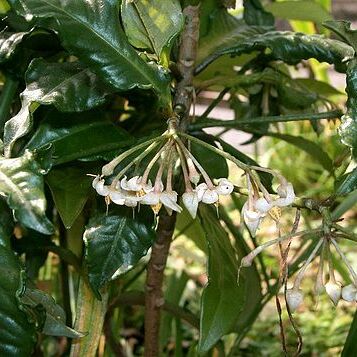Shrubs or small trees, rarely climbing or herbaceous (non-Australia). Leaves petiolate, alternate, spiral or distichous; lamina entire to crenate/serrulate, usually coriaceous, glabrous or with peltate glandular scales, hairs rare (non-Australian), glands globular and/or lineate. Inflorescence racemose usually appearing umbelliform or paniculate (not in mainland Australia) or cymose (non-Australian). Flowers bisexual, 5-merous, pedicellate; calyx free or fused at the base, persistent; corolla rotate, campanulate to urceolate (not in Australia), fused at base, lobes imbricate in bud; stamens free or adnate to the corolla tube; filaments short, rarely absent, base usually fused; anthers longitudinally dehiscent, rarely opening by pores (not in Australia), erect, often connivent around the style; ovary superior; style filiform, usually more than twice as long as the ovary; stigma punctiform; placenta basal; ovules few to numerous embedded in the placenta, uniseriate to multiseriate, 1 maturing. Fruit a drupe, style persistent or scar present, endocarp hard. Seed 1, endosperm firm, embryo transverse, cylindrical.
Shrubs, trees or woody herbs, hermaphrodite or ♀. Leaves usually marked with dark, often raised dots or streaks. Inflorescence axillary, with a bract-covered peduncle shorter than or equalling the petioles and bearing less than 12 flowers. Flowers 5-merous. Sepals and petals imbricate, the latter shortly united and sometimes contorted in bud. Stamens subsessile on lower 1/3 of petals; anthers large, dehiscing by longitudinal slits, often adnate in bud. Ovary with several to many ovules in several rows but in African species usually with placenta bearing few ovules which are in 1 row on the upper half of the placenta and attached basally to it; style long, slender; stigma minute, punctiform. Fruit globose, 1-seeded; endocarp brittle. Seed globose, covered by remnants of placenta; embryo transverse, straight or slightly curved.

